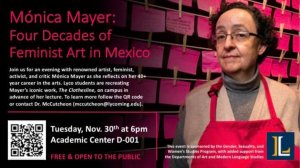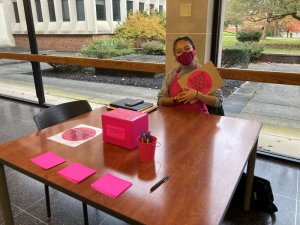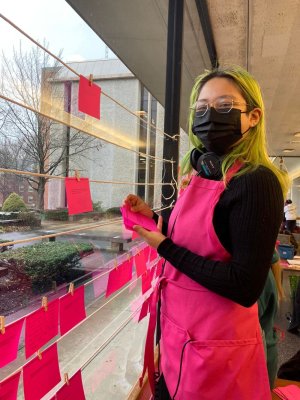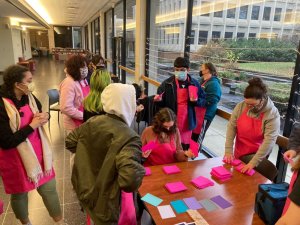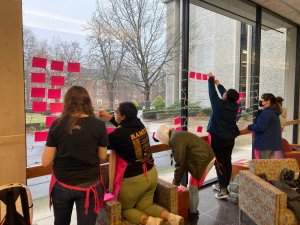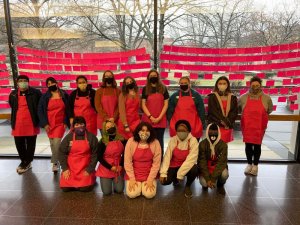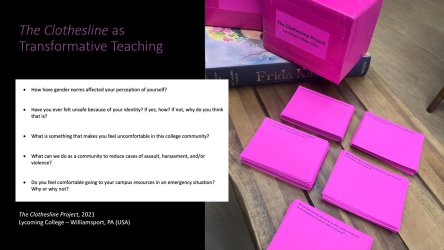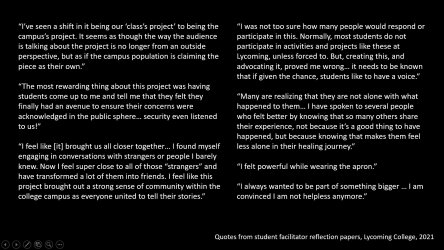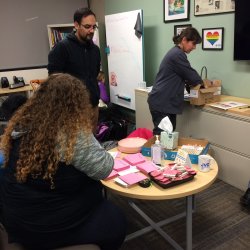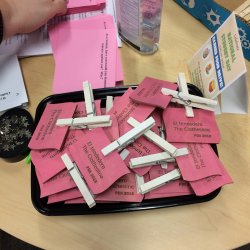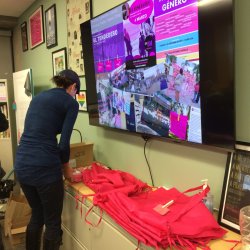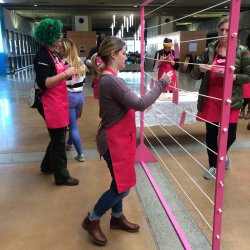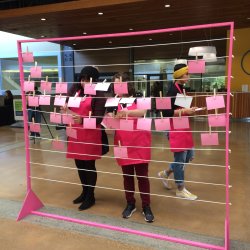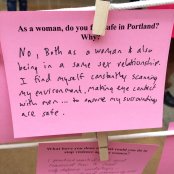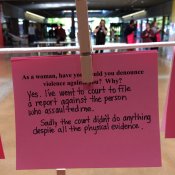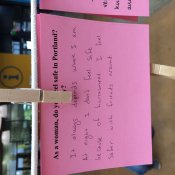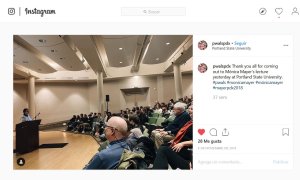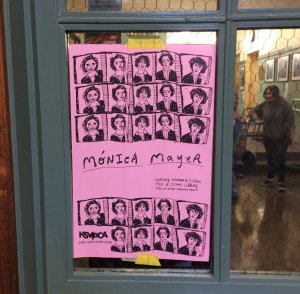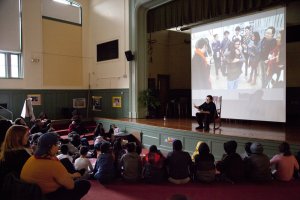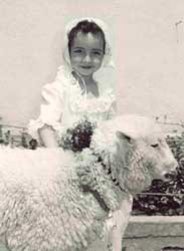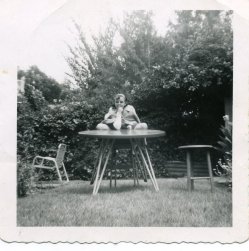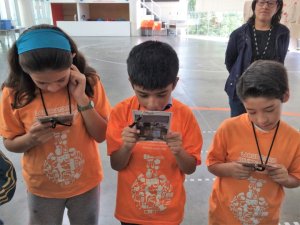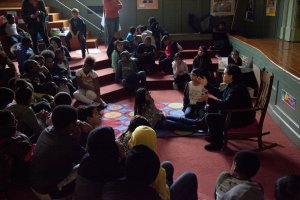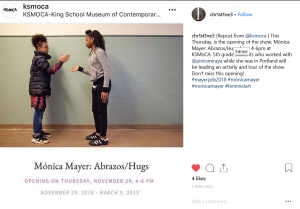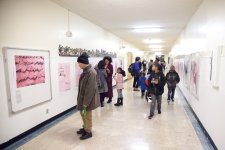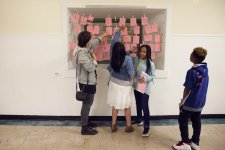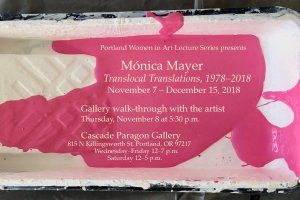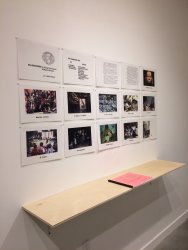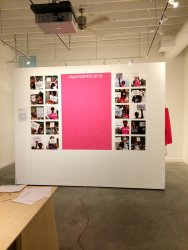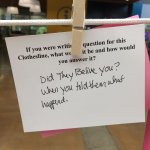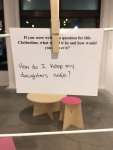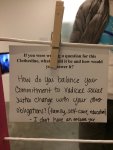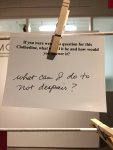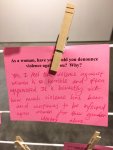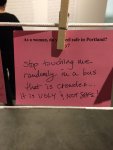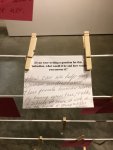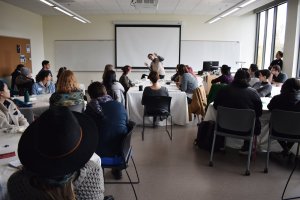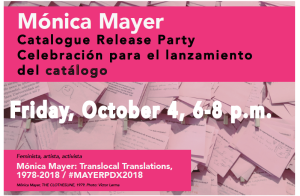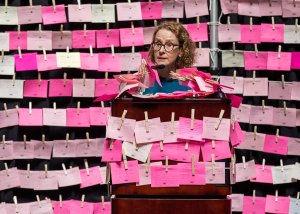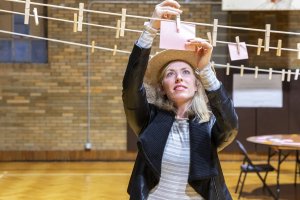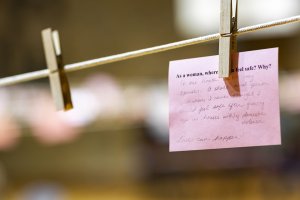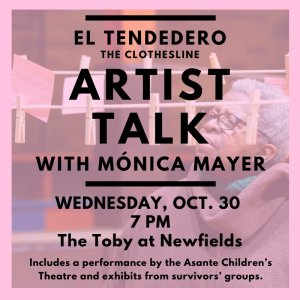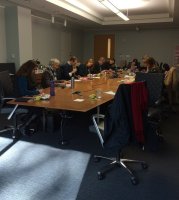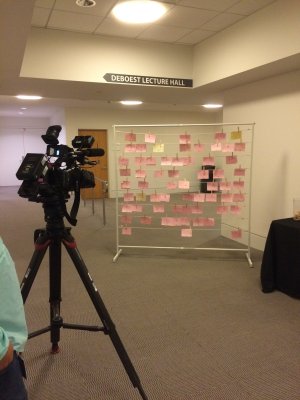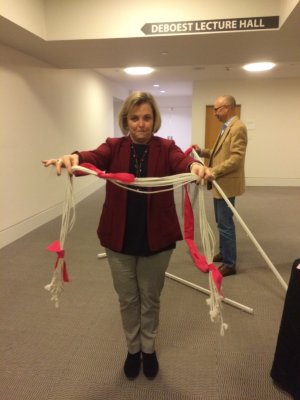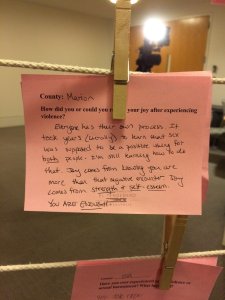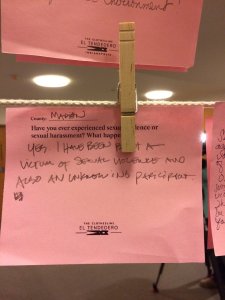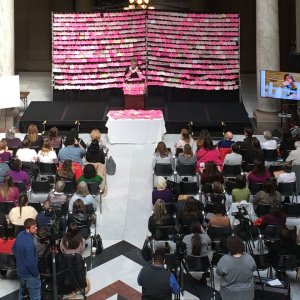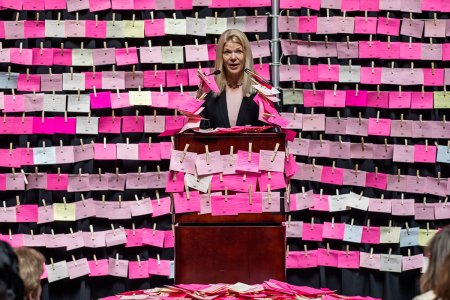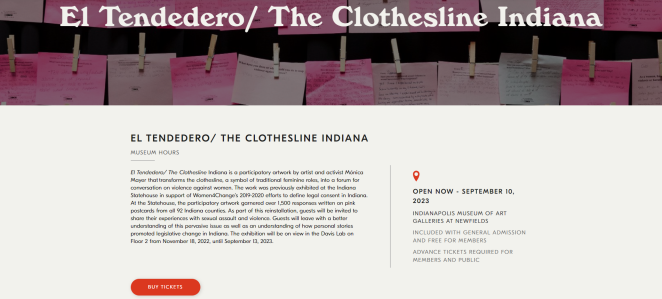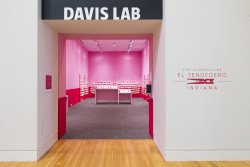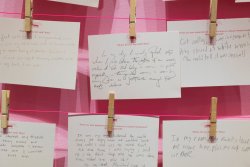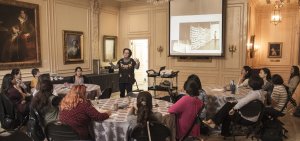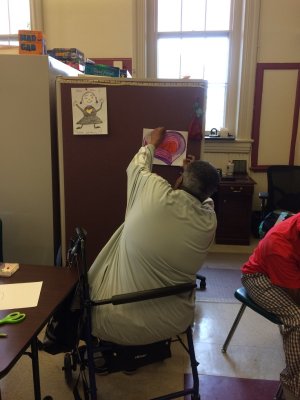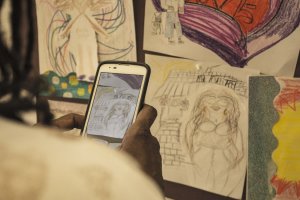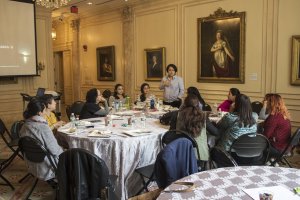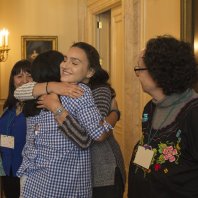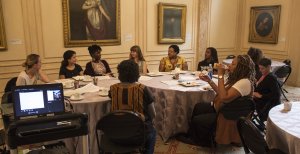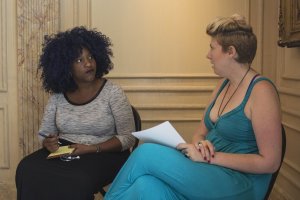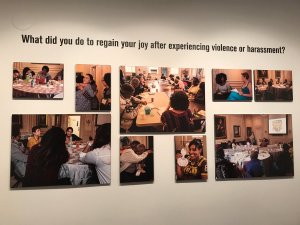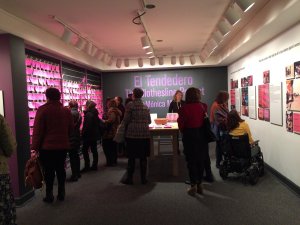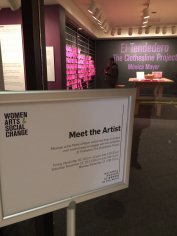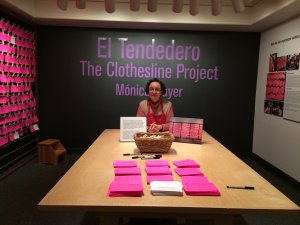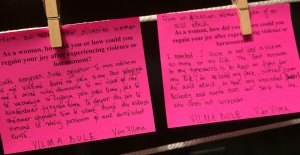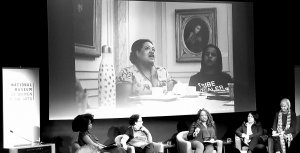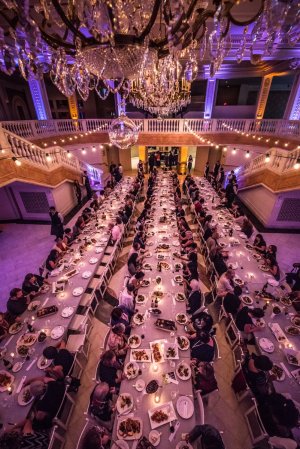Elementos filtrados por fecha: Agosto 2024
Lycoming College Clothesline (2021)
On August 2021, art historian Erin McCutcheon, whom I know because she has been researching feminist art in Mexico for many years, invited me to give a virtual lecture as part of the iteration of El Tendedero that she was planning with her students at Lycoming College.
While I didn't organize this Tendedero, I was closely involved in its development, and I knew that Erin was so familiar with the project that she could easily facilitate it, with a theoretical background that I do not possess, and with a solid understanding of the context where it was taking place.
According to Erin, she first presented the idea of reactivating El Tendedero to the students who had enrolled in her course "Gender and Sexuality in Art" to see if they were interested in participating, and everyone eagerly accepted. Throughout several classes, she shared concepts about the representations of women in visual culture and their impact, information about the forms of artivism in Mexico, and details about the history of El Tendedero, as well as my work in general.
On the other hand, they also formed a discussion group about gender violence issues they identified in their university and how they could address them through El Tendedero, as well as the most appropriate place to present it. After completing this part of the process, they defined the questions to be included in the piece and, wearing their pink aprons, they went to different parts of the campus to gather responses from fellow students. They also designed a virtual form that could be answered anonymously.
Unfortunately, as is often the case, the responses poured in. Some of them were very harsh and mentioned a person in the administration whom they claimed had not acted properly in a case of sexual assault.
Faced with this, and being aware of some of the violent reactions and/or institutional problems that some of the organizers of Tendederos de Denuncia (which have become viral in Mexican universities and instead of sharing an experience anonymously are used to denounce violence perpetrators), they began to worry about the legal implications this might lead to, and they consulted me about what I thought. We met via Zoom and discussed several strategies that I know students in Mexico have developed to protect themselves, but I mostly emphasized the importance of taking care of themselves and avoiding risks. In the end, the students decided to replace those direct accusations with blank purple cards and take the direct complaints to the university's highest authority.
According to Erin, this decision upset some of the people who had responded with direct accusations, and, when the Tendedero was set up, they replaced them. I think this is a point that we need to continue discussing because, while those who respond to the questions can defend themselves under anonymity, the same cannot be said for those who organize. I understand very well the importance of denouncing, but we must also protect those who take a stand openly.
In the end, Erin compiled a report with the accusations and presented it to the highest authority.
They opened the Tendedero 20, 2021. That day, I gave a public talk on three of my projects: El Tendedero, Maternidades Secuestradas (Abducted Maternities), and Archiva: obras maestras del arte feminista en México (Archiva: Feminist Masterpieces in Mexico). Afterward, I was invited to a small reception, which was a lot of fun because I was there remotely on a tablet, but I was able to chat with many people.
After presenting their Tendedero, Erin and her group organized a series of open forums for students to voice their concerns to various administrators responsible for resolving them.
Erin not only organized El Tendedero at her university but also participated in the 111th College Art Association conference in February 2023 at the panel "Little Pink Papers in a Hurricane; New Perspectives on Mexican Feminist Artist Mónica Mayer," with the paper "On Clotheslines, Classrooms, and Controversies: Mónica Mayer's El Tendedero as Transgressive Feminist Pedagogy.
Below, I share two images from her presentation where she discusses the questions they asked and some of the heartfelt reflections of those who participated in the project.
Texts on El Tendedero
https://sundial.csun.edu/10011/archive/ambitiousdiverseartexhibitoffeministrevolutionaries/
https://smarthistory.org/monica-mayer-clothesline/
https://nmwa.org/exhibitions/el-tendedero/
https://hammer.ucla.edu/radical-women/art/art/el-tendedero-the-clothesline-los-angeles
https://www.theguardian.com/artanddesign/2017/nov/16/the-clothesline-project-monica-mayer-sexual-abuse
https://www.seegreatart.art/monica-mayers-el-tendedero-the-clothesline/
https://laescuela.art/en/campus/library/conversations/monica-mayer-learning-to-bring-down-walls
https://www.youtube.com/watch?v=dN5exSPhzPc
https://www.youtube.com/watch?v=fLe3SYlnSBw
https://www.npr.org/sections/goatsandsoda/2017/12/10/568553773/rows-of-hot-pink-paper-all-saying-metoo
https://www.goddard.edu/blog/featured-posts/monica-mayer-forging-a-feminist-art-movement-in-mexico-city/
https://www.women4changeindiana.org/the-clothesline
https://hyperallergic.com/419827/turning-a-clothesline-into-a-powerful-feminist-statement/
https://www.eastcityart.com/openings-and-events/national-museum-women-arts-presents-monica-mayer-el-tendederothe-clothesline-project-dc/
https://www.wrtv.com/news/local-news/the-clothesline-and-its-creator-head-to-newfields-after-committee-decides-not-to-define-consent
https://www.artforum.com/print/reviews/201605/monica-mayer-59578
https://www.lennyletter.com/story/monica-mayer-mexico-feminist-art
https://www.wishtv.com/news/multicultural-news/clothesline-project-continues-to-spread-sexual-assault-awareness/
https://icesaht.org/the-clothesline-gallery-924/
https://news.msmary.edu/2018/05/clothesline-project-raises-awareness-discussion-of-sexual-violence.html
https://www.baltimoresun.com/la-et-cam-radical-women-mexico-pst-lala-20170831-htmlstory.html
https://www.smithsonianmag.com/smart-news/fifth-year-row-5womenartists-campaign-tackles-gender-inequity-180974362/
https://medium.com/@museumofwomeninthearts/timely-art-installation-attracts-metoo-audience-70f7e192e1efhttps://medium.com/@museumofwomeninthearts/timely-art-installation-attracts-metoo-audience-70f7e192e1ef
https://wamu.org/story/17/12/10/rows-of-hot-pink-paper-all-saying-metoo/
https://indymaven.com/articles/clothesline-project-indiana/
https://journals.openedition.org/artelogie/5103
The Portland Clothesline
The invitation to carry out El Tendedero in Portland began to take shape towards the end of 2017, when Alberto McKelligan informed me that, from his new position at Portland State University, he was collaborating with the organizers of The Women in Arts Lecture Series Committee and they were interested in having me give a lecture in the fall of 2018. What seemed like a simple talk, turned into a compact and intense four-day project that included two workshops, two Tendederos, an exhibition, and 4 lectures.
I met Alberto when he was working on his PHD dissertation, which he presented in 2017, titled "Mónica Mayer: Translocality and the Development of Feminist Art in Contemporary Mexico" (2017). I gladly accepted his invitation because I consider it an honor that someone would study my work so thoroughly. His work was awarded the Carolyn G. Heilburn Dissertation Prize.
My arrival in Portland on November 5th was a bit complicated and, for the first time in my life, I was stopped at immigration for over an hour and questioned about my activities in the United States, despite having letters from the universities and schools where I would be presenting my work and a return ticket.
The next day I facilitated a workshop at the Women's Resource Center at Portland Community College Sylvania, which also joined the project. In this case, since we had limited time, I shared information about previous Tendederos, gave them tips on how to invite the public to participate, and we jumped right into it. The good thing is that when you work with women who are dedicated to addressing the issue of harassment through art or institutionally, you can skip half of the information, and it's easy to be on the same page.
The questions for this Tendedero were:
- As a woman, have you experienced violence or harassment? What happened?
- As a woman, have you/would you denounce violence against you? Why?
- As a woman, where do you feel safe in Portland? Why?
- What have you done or what could you do to stop violence against women?
In order to allow the community participating in this Tendedero, whether in the workshop or by answering the questions, to address other issues, they came up with one more question on a white paper: 5. If you were writing a question for this Tendedero, what would it be, and how would you answer it? I thought that was brilliant.
I loved that instead of using printed aprons for the persons activating El Tendedero, which we often wear so people can identify we are part of a project, they made these adorable clothespin badges. New ideas always emerge with each Tendedero.
Armed with our aprons, clothespins and the desire to initiate a dialogue about harassment in this institution, we went out to seek for responses. Unfortunately, as it often happens, the clothesline structure filled up in no time.
These are some of the answers:
On Wednesday morning I explored Portland and, in the afternoon, I gave the keynote lecture titled "Translocal Translations: Feminist Art in Contemporary Mexico. A Few Decades, a Few Works, and Some Anecdotes" during which I discussed my artworks from the 1970’s while studying in Los Angeles, as well as contemporary drawings and performances.
The event took place at the Lincoln Recital Hall at Portland State University, and it was attended by a very receptive audience.
After the talk, a young person approached me to show me his drawings. Unfortunately, I didn't get his contact information, but I enjoyed his drawings.
Thursday, November 8th, was the busiest day and one of the greatest challenges I have faced as an artist. I went to King School, which is an elementary school, to give a talk to the young students, followed by a workshop where we reactivated Abrazos (Hugs), a performance Víctor Lerma and I began in 2008, and we also worked on their responses to their own El Tendedero project. The documentation of both exercises was presented as an exhibition at the school in late November. I found it inspiring that this was the first school in the United States to be named after Martin Luther King, shortly after his assassination.
Photo Anke Schuettler, KSMoCA
Giving this lecture was complex. It is not easy for me to explain conceptual art projects to young and curious individuals, particularly from a different culture, even though they had been previously introduced to my work. As part of the KSMoCA project, which brings contemporary art to the elementary school, they had been given a fun fanzine explaining my works.
I tried to share the idea of performance art in a playful way. For example, regarding Translations: An International Dialogue of Women Artists, I told them it was a way of building a bridge. To talk about ¡MADRES! the performance Maris Bustamante and I as the feminist art collective Polvo de Gallina Negra (Black Hen’s Dust) on Guillermo Ochoa’s television program where we named him Mother for a Day https://youtu.be/oPu9-XWFzCk, I explained it was role playing. For Carta a mi Madre (Letter to My Mother), which was also a piece by Polvo de Gallina Negra, I told them it was about writing a secret message, and I said that El Tendedero was a way of inviting everyone to participate. Finally, Abrazos (Hugs), the piece we were going to reactivate, was simply a way to share stories.
To try to connect, I started the lecture by showing them two photos of myself at their age. The first one was when I recited Mary had a little lamb in kindergarten, and they were only able to get a sheep which was so big it almost pulled me out of the stage, and the second one was me imitating my sixth-grade teacher.
I ended the lecture with a photo of one of the iterations of Abrazos at the Museo Universitario de Arte Contemporáneo (MUAC) in 2016 during a summer course at the museum.
Photo Anke Schuettler, KSMoCA
To set the stage, I asked them to lend me a rocking chair that was around, assuming the role of a grandmother, which I love. We engaged in an intense dialogue for a few minutes, until they got bored.
We then moved to the workshop, and it was very interesting because their regular teachers, art teachers, and a bunch of university assistants supporting the project were present. However, it was challenging for me, and I had to improvise along the way. I'm not used to working with children, especially in the United States.
I had initially planned to do all of this during the workshop, but I didn't take into account that many pre-teens don't like hugs, especially with their classmates. As a result, they ended up designing different ways to greet each other, which was a lot of fun.
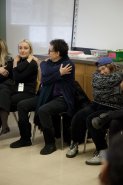
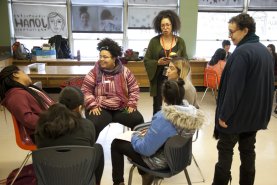
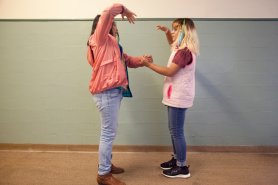
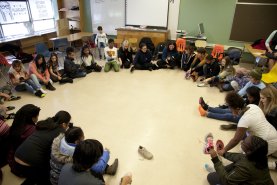
Photo Anke Schuettler, KSMoCA
At a certain point, I came up with the idea of playing the Mexican song called Acitrón de un Fandango and passing something around in a circle to synchronize the group, but it turned into chaos. Fortunately, the teachers redirected the activity. The day ended with them responding to the question for this unique Tendedero which was: "What would make you happier at your school?"
Halfway through the workshop, the alarms went off because a drill was programmed and we all had to evacuate the school and go to a field nearby.
This is the invitation to the exhibition that took place on November 29th and some of its photographs.
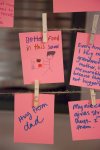

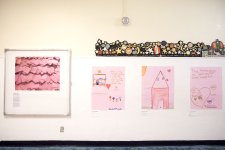
Photo Anke Schuettler, KSMoCA
I was exhausted, but there was still a lot ahead.
The next stop was the opening of my exhibition Translocal Translations, 1978-2018 at the Cascade Pragon Gallery, where I also gave a guided tour to a full house. The gallery is small, but they did an excellent job of displaying El Tendedero and several other pieces, including Lo Normal, Traducciones, Maternidades Secuestradas, and the video of Madre por un día by Polvo de Gallina Negra.
Since it was a university gallery without budget for international artwork shipments, insurance, etc., we presented a couple of facsimiles and documentation, which can be reproduced without altering its essence. I like doing exhibitions this way because I simply send the images, and they are produced on-site according to their specific size requirements.
In this exhibition, El Tendedero had a prominent place, and they arranged the space well for the audience to sit and respond or read some of the feminist art bibliography they made available.
Here are some of the responses.
But the day turned into night, and after the opening, there was a dinner for academics from Portland Community College at the June Key Delta Community Center, where I gave a brief speech and engaged in a dialogue. By that point, I was so tired that I can't even remember what I talked about.
It was a long, exhausting, productive, and interesting day.
Photo Anke Schuettler, KSMoCA
On the last day of this intense trip, I was invited to the Rising Stars Luncheon program at the PCC Rock Creek Campus, where I had a dialogue with students. Then they took me to visit their Women's Resource Center. I love the attention that U.S. universities pay to gender issues.
Although the trip was intense, I was grateful to all the institutions, programs, and people who collaborated to make it possible. The icing on the cake was that they published a catalogue of all of these activities.
The Catalogs of the Tendederos de Portland / The Portland Clotheslines
Since I was at art school in Mexico City during the early seventies, I have understood the importance of having a catalog after every exhibition. Unfortunately, I haven't always achieved that goal, although I have tried to document all my work. That's why I am immensely happy that the Tendedero de Portland / Portland Clothesline project produced two catalogs.
The first one was about the collaboration between KSMoCA, the students from Dr. Martin Luther King Jr. School, and myself. In this collaboration, after a lecture and a workshop, the students created a series of drawings depicting the hugs that had been important to them. Later, these drawings of hugs were presented as a Tendedero, along with documentation of previous iterations of the artwork. Some of the hug drawings are deeply moving. Take a look at them here.
The second catalog encompasses the rest of the activities during this visit, including talks and the exhibition at the Paragon Gallery. The catalog features texts by Christine Weber and Alberto McKelligan Hernández. You can find the catalog here.
It's worth mentioning that both catalogs are bilingual.
The Indiana Clothesline (2018)
Photo: Samantha Mccain Veach
Introduction
El Tendedero has been used in different ways, but it was particularly interesting in Indiana because the piece was adopted as a political tool by Women4Change https://www.women4changeindiana.org/ who used it to help them modify consent laws in cases of sexual abuse in Indiana.
On June 2018, Ann Stack (from Women4Change) contacted me to activate the piece in Indianapolis. She had seen El Tendedero at the National Museum of Women in the Arts https://nmwa.org/exhibitions/el-tendedero/ and thought it could be a useful tool for them.
Women4Change held a first trial iteration of El Tendedero on November 2nd to understand how to involve other institutions and to define the strategies needed in this collaboration between their group, the staff at the Indianapolis Museum of Art where it would take place and myself. You can see some of the documentation here https://sammcveachphoto.passgallery.com/-theclotheslineproject/gallery
In late 2019, I conducted two workshops and gave a lecture for those who would be responsible of replicating the workshop and the iterations.
On March 5th, 2020, The Indiana Clothesline with the thousands of responses they gathered were set up as a protest at the State Congress.
Subsequently, an exhibition was mounted as a tribute to El Tendedero, in which 3 artists from the United States participated. You can see the virtual tour here. https://my.matterport.com/show/?m=YfzjcnQVmQ4&fbclid=IwAR1f0Dlys66YscbLHjdPsVFsclP1fXfFxTGCmVbCLgl7YzPDhGR_6l9cHhM
For more information, visit Women4Change's Facebook page. https://www.facebook.com/Women4ChangeIndiana
The Beginning
Photo: Samantha Mccain Veach
I am continually amazed by the different ways in which each community appropriates El Tendedero. In this case, The Indiana Clothesline, which is supposed to conclude by late 2020, it has been taken up by a group of women as a tool to gather responses about sexual harassment in their State, present them to their Congress, and demand legislative changes. I have accompanied the process from the beginning, but the women who invited me already had a clear understanding of what they wanted to achieve and how.
On June 2018, I received an email from Melani Douglass from the National Museum of Women Artists, where I had done a Tendedero in 2017, informing me that Ann Stack had contacted them because they wanted to do it and asked if I could share my contact information. Naturally, I agreed, and shortly after, I received a warm email from Ann, stating that she had read about the project in the museum's magazine and wanted to bring it to Indianapolis. She is an active member of a nonpartisan, community-based, collaborative organization called Women4Change Indiana, and she had already reached out to Preston Bautista, Interim Director of Public Programs at the IMOCA, the Harrison Center, and other groups to invite them to participate.
After our initial conversations, they decided that they wanted to conduct a pilot Tendedero to understand how it worked. This first iteration took place on November 2, 2018, at the Harrison Center.
In the words of Joanna Taft, the executive director of the center: "It was an amazing night. One of the participants commented that it was the most silent and yet most thunderous exhibition at the Harrison Center. People approached the space reverently and solemnly. Many wiped tears from their eyes. They hugged each other. They reflected. Writing was constant. We used the 5,000-square-foot room so that people could slowly navigate through the exhibition and think." You can find the complete photographic documentation of that night, taken by Samantha Mccain Veach, right here. https://sammcveachphoto.passgallery.com/-theclotheslineproject/gallery
Photo Samantha Mccain Veach
They kept the cards and the rest of the materials to continue using them.
Over the following weeks, we kept a lively correspondence and had some Skype conversations, discussing goals, strategies, and practical issues, and gradually, the project took shape. In August, they put me in touch with Lindsay Hamman, the Director of Public Programs, and Bryn Jackson, the Curatorial Assistant for Performance and Public Experiences, both from the Indianapolis Museum of Art, and we started working with the organizations on a long list of topics that could be addressed in El Tendedero. In the end, they decided to focus on sexual violence in an effort to change the law regarding the definition of consent.
On Tuesday, October 29, 2019, I traveled to Indianapolis to give a lecture and conduct two workshops with the people who would be responsible for replicating El Tendedero throughout the state of Indiana. The workshops took place on the 29th and 30th. It was one of those intense and compact trips that have characterized the iterations of this piece.
Everything would have gone perfectly, but on Wednesday afternoon, after they gave me a guided tour of the museum and we went for lunch, I returned to the hotel to rest a bit before my lecture and suddenly got very sick to my stomach and the talk had to be rescheduled for Friday.
The workshops went smoothly, and it was interesting because the participants are usually artists and activists who have worked on issues of sexual violence and are therefore open to discussing even their own personal experiences, and in this case, they were mainly curators and officials from museum and social institutions, so the atmosphere was more formal. However, I believe that by the end, I achieved the goal of them owning the issue and strengthening their networking efforts.
Friday was a very, very long day. After the morning workshop, the photographer documenting the entire process for the final exhibition arrived, and we had a session. I tried to be as professional as possible, but I tend to clown around because, as much as I enjoy public speaking, I hate posing for photos.
The lecture took place that evening, preceded by a couple of interviews. Due to its goals, this Tendedero required significant publicity. The strange thing was that I was asked about local political issues, and obviously, there was no way to respond other than with generalities.
We started the evening with a group of young people staging a beautiful poem by Audre Lorde, and then it was my turn. The lecture had a good turnout, but not as good as it would have been if it had taken place on Wednesday, as originally planned.
One thing I loved was that just outside the conference room, they set up a small collapsible Tendedero, complete with its own bag where everything could be packed. It's designed to fit in any car. I was thrilled.
Photos Mónica Mayer
By the end of the lecture, this Tendedero had almost filled up.
These are a couple of the answers.
And the story continues...
For several months, the excellent team that coordinated El Tendedero managed to reach every physical and virtual corner of the State of Indiana to obtain answers for the piece, culminating in a grand event on March 5, just a few days before the coronavirus pandemic hit us. I hadn't planned to attend that event, but I followed it closely on social media.
This is what their invitation to participate said:
On March 5th, Women4Change will take the voices of women who have been sexually assaulted or have witnessed sexual assault to the Indiana Statehouse to create awareness among lawmakers of the extent of the problem. The goal of El Tendedero/The Clothesline is to create conversations that lead to legislation and a cultural shift that eliminates sexual assault and harassment in Indiana.
Clotheslines will be put up in the South Atrium and completed postcards with the stories of women from all over Indiana will be displayed for two weeks after the event. If you would like to share your story and fill out a postcard to be hung on a clothesline at the Statehouse, click the link below. All responses will be anonymous.
You can find a detailed description of the event and all the activities here https://www.women4changeindiana.org/the-clothesline. It is impressive.
The results of the Project were outstanding and eventually they achieved the legal results they sought.
El Tendedero was set up a second time at Newfields between November 18, 2022 and September 13, 2023. These are some of the photographs of this long iteration.
The following are some of the articles written about the piece.
-Clothesline Project seeks to educate about sexual assault and provoke change. Cornelius Hocker. RTV6 Indianapolis. Noviembre de 2019.RTV6 Indianapolis. Novenber, 2019. https://www.wrtv.com/news/working-for-you/clothesline-project-seeks-to-educate-about-sexual-assault-and-provoke-change?fbclid=IwAR065NMb6lENgz3KXWW6BAvmHHJzM6FBBc1O9Aaw_aQe8j57g12RpTZo5IU
-Speaking up, one note card at a time. Mary Beth Schneider. The Statehouse File. October 31, 2019. https://www.thestatehousefile.com/commentary/commentary-speaking-up-one-note-card-at-a-time/article_1e3e897a-fa4c-55ea-8767-3bf17a2a9f96.html
-Study Committee on Consent Announced. Jen Schmits Thomas. Women 4 Change. May 13, 2020. https://www.women4changeindiana.org/news/2020/5/13/study-committee-on-consent-announced?fbclid=IwAR2F3Dgzwaw-AIo_giIhzo2W54VeaLD8W3Bx1fB2ivvJIpHRYb6rXPS7dhc
-Legislature to study how to handle emergencies. Haley Carney. Greensburg Daily news. May 15, 2020. https://www.greensburgdailynews.com/news/around_indiana/legislature-to-study-how-to-handle-emergencies/article_a2dd811a-96ca-11ea-8777-231834e6f1cf.html
-Maven to Know: Rima Shahid. Samantha Kupiainen. Indy Maven. August 11, 2020. https://indymaven.com/articles/maven-to-know-rima-shahid/?utm_source=Indy+Maven&utm_campaign=c5e9f46ca3-EMAIL_CAMPAIGN_2020_08_06_07_10&utm_medium=email&utm_term=0_26dca66f4e-c5e9f46ca3-377055813&mc_cid=c5e9f46ca3&mc_eid=678c6c99f6
-Clothesline project continues to spread sexual assault awareness. Katiera Winfrey. Wish TV. November 4, 2020. https://www.wishtv.com/news/multicultural-news/clothesline-project-continues-to-spread-sexual-assault-awareness/
-El Tendedero/The Clothesline Indiana: Homage & Celebration. Arts Council of Indianapolis. November 12, 2020. https://indyarts.org/component/content/article/23-gallery-924/exhibitions/255-el-tendedero-the-clothesline-indiana-homage-celebration?fbclid=IwAR0v-ip7vEv88qf4E8tFGhID1uUFbBHNk33nAYtF8VmmXbwY0DVhCs2ZJKQ
-Newfields to acquire contemporary installation El Tendedero/The Clothesline Indiana. Redacción. Art Daily. November 20, 2020. https://artdaily.com/news/129786/Newfields-to-acquire-contemporary-installation-El-Tendedero-The-Clothesline-Indiana#.YBBSDuhKiUl
The Clothesline / El Tendedero Indianapolis: Conversation with Mónica Mayer & Karen Cordero Reima. December 8, 2020. https://www.youtube.com/watch?v=2BS5FHCqOE4
The NMWA Clothesline (2018)
Photo: Kevin Allen, National Museum of Women in the Arts
On September 2017, I went to Washington to conduct three workshops to activate El Tendedero at the National Museum of Women in the Arts (NMWA).
The groups, selected by the museum, included House of Ruth (a shelter for battered women), La Clínica del Pueblo (an organization that provides support to migrants), and a group of local artists and activists.
El Tendedero was shown between November 10, 2017 and January 5, 2018, during the height of the #MeToo movement. This was the first time the piece had an exhibition of its own. All the information was bilingual, with cards and instructions provided in both English and Spanish. El Tendedero was displayed on a wall, there was a table in the middle of the room with materials to activate the artwork, and the wall in front showed documentation of past Tendederos and the of the workshops.
I also participated in the museum's public program by giving an inaugural talk https://www.youtube.com/watch?v=dN5exSPhzPc and was part of a panel discussion with Maurissa Stone Bass (The Living Well) and Dilcia Molina (La Clinica del Pueblo) that was moderated by Melani Douglass, the Director of Public Programs at the museum. https://www.youtube.com/watch?v=MOj2s7oQ4cQ
Photo: Yuruen Lerma
How did it all begin?
On November 2016, a group of supporters, artists, and associates from the National Museum of Women in the Arts (NMWA) in Washington had visited my studio in Mexico City and I spoke about my work and gave them a tour of the Pinto mi Raya Archive. One of the visitors was the honorable Mary V. Mochary, a recognized judge and Republican politician who showed a great interest in having the museum acquire El Tendedero. I explained that I felt it would be unethical to profit from women’s pain, so I could not sell it, but if my expenses were covered, I would gladly go to Washington to create a new Tendedero.
The project went ahead, and on September 2017, my daughter Yuruen Lerma and I went to Washington to start it. At the time, the #MeToo movement was unfolding, serving as a backdrop for its presentation in November. Unlike other Tendederos in which I have collaborated with artists and activists, the museum wanted me to work with specific communities they were reaching out to, such as the House of Ruth, a shelter for battered women, and La Clínica del Pueblo, an organization that provides services to migrant communities. The idea was to conduct three workshops: one in each of these organizations and another one with artists and activists. In these workshops, we would define the questions for this Tendedero, and, those who wanted to, would take them to their communities to gather responses.
I accepted because I like each Tendedero to be different, as it allows me to face different contexts and learn from everyone participating, even though I always prefer to work with women who themselves organized the piece or who chose to participate. However, I knew it would be a challenge, so I invited Yuruen to collaborate with me. As a psychologist with master's degree in gender studies, she has extensive experience with diverse groups. What I didn't anticipate was how complex it is to work in a culture as foreign to me as the United States.
Photos Yuruen Lerma
The House of Ruth workshop was difficult for several reasons, among them their specific situation facing violence, but there were also issues of culture, class and race that work very differently in the US and in Mexico and that I simply didn't understand. It took me a while to grasp the dynamics and create the necessary trust for the questions of El Tendedero to emerge from their own concerns. In the end, we succeeded, and one of my favorite questions of all times came from this group: "As a woman, what have you done or would you do to regain joy after being mistreated?" Coming from my culture, joy had never been a goal to reach as part of the struggle against violence. Their question made me change.
Photo: Yuruen Lerma
The group from La Clínica del Pueblo flowed more easily. As soon as we greeted as we do in Mexico with hugs, kisses, and affection, I felt at home.
Participation in the workshop was constant and critical, allowing me to better understand the problems faced by migrant women in terms of gender-based violence, especially in the Trump era. Talking with them made it clear to me that countless women in the US cannot afford to report the violence they endure out of fear of being deported. The laws are supposed to protect them, but they have good reasons not to trust the authorities. In this Tendedero, apart from the answers gathered at La Clínica del Pueblo, we left some blank slips on white paper to visibilize those who are unable to speak up. It was particularly important because, as I mentioned, the NMWA Tendedero was presented at the height of the #MeToo movement, when renowned actresses publicly spoke up against harassment in the entertainment industry, and what these little pieces of paper highlighted was that even reporting harassment is still a matter of privilege. In the workshop, I met Dilcia Molina, in charge of the Gender and Health Program at La Clínica del Pueblo. Fortunately, this wise and admirable woman was strong ally of El Tendedero.
Photos Yuruen Lerma
The last workshop was with artists and activists from Washington and Baltimore. It was not easy either. Racial tensions in Washington were strong, and a couple of intense discussions arose around gentrification that overwhelmed me. Additionally, in that context, I was in a difficult situation because, while I am white, I am also Mexican, and one who, having lived in the U.S. for two years, is painfully aware of the enormous prejudice that exists in the United States against us, in general, in the artworld and even in part of the feminist movement, so it was hard for them to place me. However, I found a great ally in Maurissa Stone Bass, a very loving woman and the director of The Living Well, where they had held their own Tendedero on November 3rd during an event called Baltimore Peace Challenge #HealinCommUNITY, which later became part of the one at the NMWA.
Photos Yuruen Lerma
El Tendedero del NMWA / The NMWA Clothesline II: THE INSTALLATION
Photo Kevin Allen, National Musum of Women in the Arts
El Tendedero del NMWA in Washington was beautiful. It was alone in a room at the entrance of the National Museum of Women in the Arts. The little pink slips of papers and purple letters stood out against the dramatic black wall as a backdrop. In the center, on a prominent high table, were the slips in English and Spanish for the public to fill out, along with the instructions. On the wall to the left was El Tendedero.
Photo Kevin Allen, National Museum of Women in the Arts
The information from previous Tendederos was displayed on the wall to the right.
Photo Kevin Allen, National Museum of Women in the Arts
The documentation from the workshops, the explanation of the process, the exhibition credits, and acknowledgments of sponsors were placed on a small nook on the left side, at the entrance of the room.
This is the first time that El Tendedero was presented on its own. It had always been part of group shows or my solo shows which included other artworks.
Based on the workshops, we decided to include five questions:
Have you been mistreated because you are a woman? In what way?
Have you reported or would you report mistreatment as a woman? Why?
Where do you feel safe as a woman? Why?
What have you done or could you do against violence towards women?
As a woman, what have you done or would you do to regain joy after being mistreated?
Photo Mónica Mayer
I thought the Tendedero would be difficult to fill up, but both the audience and the responses kept flowing. There were many reports of violence against women, but also many answers about personal, educational, legal, and political actions against this sort of violence.
Photo Mónica Mayer
I love to interact with the audience and activate the artwork, so, during the days I was in Washington, I spent my time at the installation in the museum.
It was very interesting. For example, an artist around my age asked me what I do when I'm not working on El Tendedero, and we ended up having a long conversation about the multiple jobs we have to do to survive and support our art work. The situation in the US is not that friendly towards artists as I thought. Many university students also came because their gender studies teachers sent them. I asked them about the prevalence of harassment at their university, and at first, one student said she hadn't noticed any. We continued talking, and I mentioned that I had read that there were many cases of rape during parties or dates among students. She then told me that she doesn't go to parties because the first time she attended one, a group of guys pulled her around, tugging at her pants, so, although nothing else happened, she stopped going. It hadn't occurred to her that this was also harassment. But the ones that touched me the most were two young women who entered, started texting, and then filled out a response about how to regain joy, which they showed me: they had written to Vilma Dulce, a friend of theirs in Algeria whose face was disfigured by the acid thrown at her by a guy. The response, on the photograph below, still makes me cry.
Photo Mónica Mayer
The answers and the documentation of El Tendedero del NMWA remained at the museum and they also digitalized all the answers which can be consulted on line in the exhibition’s webpage. https://nmwa.assetbank-server.com/assetbank-nmwa/images/assetbox/58122d51-7da6-4710-8ac4-07f43530088d/assetbox.html
El Tendedero del NMWA / The NMWA Clothesline III: The Forum
Photo Kevin Allen, National Museum of Women in the Arts
The Public Programs department, directed by Melani Douglass and coordinated by Alicia Gregory, is one of the areas that is gaining increasing relevance at the National Museum of Women in the Arts, and my project was one of the first or perhaps the first social practice project at the museum, so we worked closely.
Photo Jennifer Folyanan
The experience was very interesting and I felt the museum truly embraced the project. The museography was splendid, the publicity was top-notch, and the project organization came from a solid and committed team effort. I would like to illustrate this with the last component of the project: the Fresh Talk Forum held on November 12, 2017.
The forum program included a brief lecture I gave about El Tendedero and a panel moderated by Douglass in which Dilcia Molina from La Clínica del Pueblo, Maruissa Stone Bass from The Living Well, and I participated. In the end, it was opened to the public, and we concluded with a dinner attended by approximately 200 people who were in the auditorium.
You can find my talk here and the panel here. https://www.youtube.com/playlist?list=PL1boWZ4URBmqUMI1MufoGJ6YTMkd2YpAS
Photo Kevin Allen, National Museum of Women in the Arts
Before we started, Melani asked the audience who knew me or my work, and only a couple of people raised their hands. To me, this meant the museum had done a great job inviting people. But I realized it was more than that when, at the end of the panel the moderator, instead of inviting the audience to ask questions, asked them to share their own strategies and actions against violence against women. The entire audience consisted of people dedicated to working on gender issues who came from academia, anti-violence organizations, and artist collectives working on these issues. They had actually handpicked their large audience, laying the grounds for a real conversation and strengthening networks.
However, what I remember the most were the words of a woman born in Guadalajara, Mexico, living legally I the United States, who mentioned that she had recently been forced to explain to her elementary school children the meaning of the word rapist because other kids at school had told them that if they were Mexican, they were rapists. Between gender-based violence and racism (among other forms of oppression), we are living in difficult times.
Photo Kevin Allen, National Museum of Women in the Arts
That night, during the dinner at the splendid museum, any doubts I had about the results of the workshop at The House of Ruth disappeared. Several women from the House attended the forum and participated enthusiastically. Most of them had never been to a museum before. They greeted me warmly, and it was evident that they were having a good time. A large contingent from La Clínica del Pueblo also arrived. One of them mentioned that many migrants didn't even go near that part of the city because there were many government buildings, or they thought they would be asked for an ID at the entrance of the museum, and they were afraid of being caught. I saw only a few of the artists and activists from the last workshop. Interestingly, that was the least successful meeting.
Something that pleasantly impressed me about the NMWA Tendedero was the project's presence in the media, with articles in newspapers such as The Washington Post and The Guardian, among many others. I don't know if the project caught their attention, if the museum's press department does an excellent job, if covering Mexican projects is a form of resistance against Trump, or if the presence of the #MeToo movement helped to turn the spotlight towards the piece, but the coverage was very good.
Undoubtedly, I was pleased with all this attention to my work, but I thought it was important because until very recently, the history of feminist art has come mostly from the United States and Europe. Little by little, we have to change that narrative.
These are the links to some of the articles.
Turning a Clothesline into a Powerful Feminist Statement by Mallory Nezam. Hyperallergic, January 3, 2018.
Before #MeToo, There Was El Tendedero by Kristin Kirsch Feldkamp. She files, December 31, 2017.
Interactive exhibition invites visitors to leave comments about sexual abuse and harassment. Art Daily. December, 2017
Rows Of Hot Pink Paper, All Saying #MeToo by Greta Jochem, Goats and Soda, December 10, 2017.
#MeToo, the analog way: Survivors tell their stories with ‘The Clothesline Project’ by Jessica M. Goldstein. Think Progress, December 4, 2017.
The Clothesline Project: an Exhibit Asking to Share Stories of Sexual Abuse by Nadja Saye. The Guardian, November 16, 2017.
Timely Art Installation Attracts #MeToo Audience por Susan Focher Sterling. The Huffington Post, November 14, 2017.
Art installation on sexual harassment and violence opens at Museum of Women in the Arts by Peggy McGlone. Washington Post, Arts and Entertainment. November 13, 2017.

